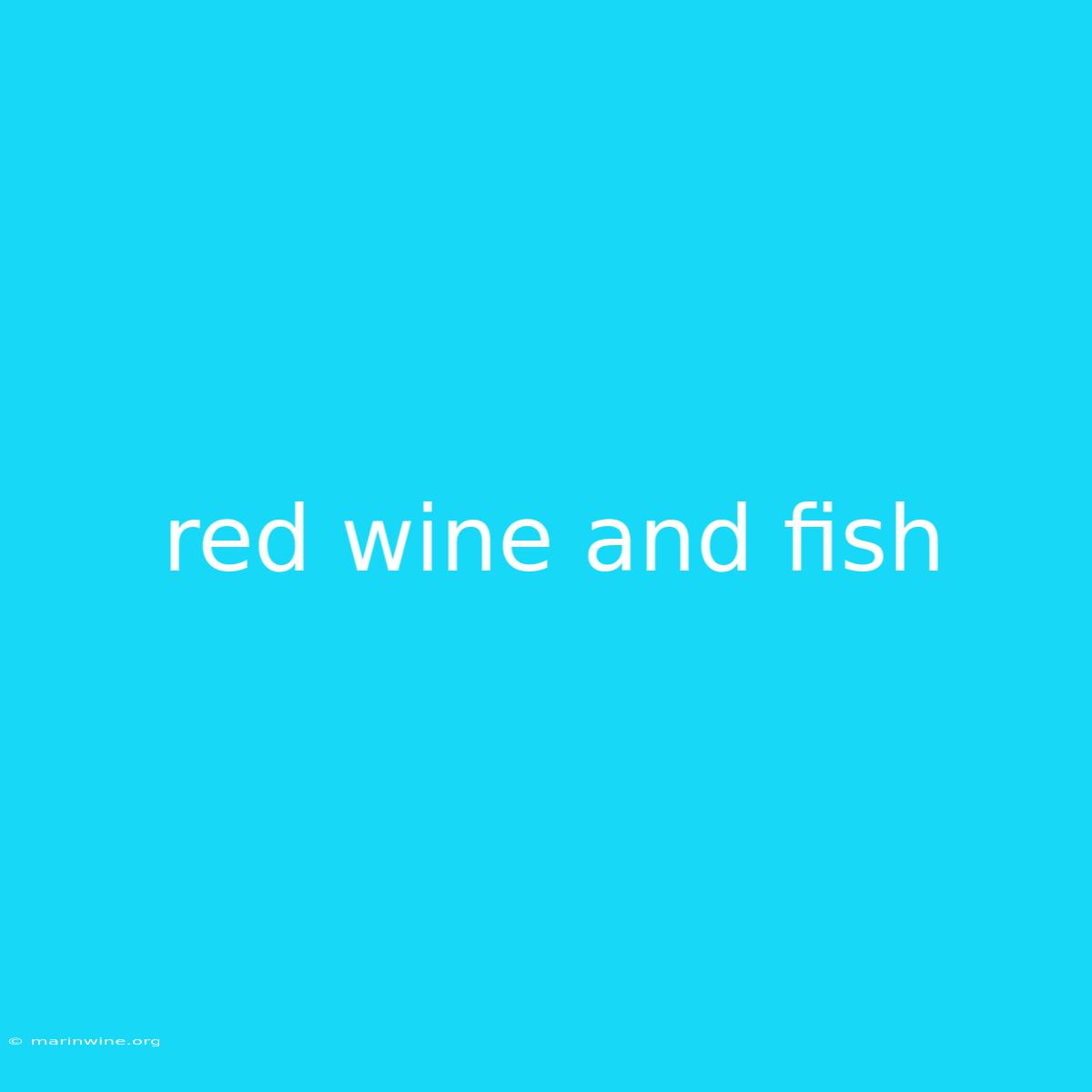Red Wine and Fish: A Surprisingly Delicious Pairing
Is red wine really good with fish? You might be surprised to learn that it can be, and it's a combination that offers a world of flavor possibilities. While the traditional pairing of white wine and fish has long been considered the norm, red wine can actually complement the delicate flavors of seafood in a surprisingly delightful way.
Why It Matters: Exploring the fascinating pairing of red wine and fish expands your culinary horizons, challenging preconceived notions and opening up a new realm of taste experiences. This pairing also highlights the importance of considering the specific characteristics of both the wine and the fish to achieve a harmonious blend.
Key Takeaways of Red Wine and Fish Pairing
| Wine Characteristics | Fish Characteristics | Pairing Notes |
|---|---|---|
| Light-bodied, high-acid reds (e.g., Pinot Noir, Beaujolais) | Delicate fish (e.g., Salmon, Trout, Tuna) | The acidity cuts through the richness of the fish, while the lighter tannins complement the subtle flavors. |
| Medium-bodied reds with earthy notes (e.g., Cabernet Franc, Syrah) | Hearty fish (e.g., Swordfish, Tuna, Halibut) | The earthiness of the wine complements the robust flavors of the fish, while the tannins help balance the richness. |
| Full-bodied reds with fruit forward notes (e.g., Merlot, Zinfandel) | Grilled or pan-seared fish (e.g., Swordfish, Tuna, Salmon) | The fruitiness of the wine complements the char of the grilled fish, while the full-bodiedness provides a satisfying contrast. |
Red Wine and Fish: Exploring the Connection
Choosing the Right Red Wine:
The key to a successful red wine and fish pairing lies in choosing the right wine based on the fish's characteristics and cooking method.
- Light-bodied reds with high acidity and low tannins work well with delicate fish, such as salmon, trout, and tuna, prepared using gentle cooking methods like poaching or baking. These wines help cut through the richness of the fish without overpowering its delicate flavors.
- Medium-bodied reds with earthy notes and slightly higher tannins are a good match for hearty fish, such as swordfish, tuna, and halibut, which have a stronger flavor profile. The earthiness of the wine complements the savory notes of the fish, while the tannins provide a pleasant counterpoint to the richness.
- Full-bodied reds with fruit-forward notes and higher tannins can complement grilled or pan-seared fish, enhancing the char and smokiness of the cooking method. The fruitiness of the wine balances the richness of the fish, while the boldness of the wine complements the robust flavors.
Understanding the Role of Acidity:
Acidity plays a crucial role in balancing the richness of the fish and preventing the wine from feeling too heavy. High acidity cuts through the fat and oil in the fish, refreshing the palate and enhancing the overall experience.
Exploring the Importance of Tannins:
Tannins, found in red wines, provide structure and complexity. They can help balance the richness of the fish and create a pleasant contrast in the palate. However, it's important to note that excessive tannins can overpower the delicate flavors of the fish. Therefore, selecting reds with moderate tannins is essential.
The Influence of Cooking Method on Wine Selection
The way you cook the fish also influences the type of red wine that will pair best. For example, a lighter red like Pinot Noir might work well with poached or baked salmon, while a more robust red like Cabernet Franc could be a better choice for grilled or pan-seared swordfish.
Red Wine and Fish: Beyond the Basics
While the above guidelines provide a starting point, exploring different red wine and fish combinations can lead to exciting discoveries. Experimenting with different wines and fish, as well as exploring the influence of cooking methods and accompanying sauces, can unlock a world of culinary possibilities.
FAQ for Red Wine and Fish Pairing
Q: Can any red wine be paired with fish?
A: While many red wines can be paired with fish, choosing the right one based on the fish's characteristics and cooking method is essential.
Q: What types of red wine are best for salmon?
A: Light-bodied reds like Pinot Noir, Gamay, or Beaujolais are good choices for salmon, especially when cooked gently.
Q: Can red wine be paired with grilled fish?
A: Yes, but choose a red wine that complements the char and smokiness of the grilling process. Full-bodied reds with fruit forward notes can enhance the flavor profile.
Q: What about white wine and fish?
A: White wine remains a classic pairing with fish, offering refreshing acidity and complementary flavors. However, don't discount the potential of red wine to create an equally delightful experience.
Q: What are some tips for pairing red wine with fish?
A: Consider the fish's flavor profile, cooking method, and any accompanying sauces. Choose a red wine with acidity, tannins, and flavor notes that complement the dish.
Tips for Pairing Red Wine and Fish
- Start with a light-bodied red for delicate fish. Pinot Noir, Beaujolais, or Gamay are good options.
- Choose a medium-bodied red for heartier fish. Cabernet Franc, Syrah, or Merlot can provide a satisfying balance.
- For grilled or pan-seared fish, consider a full-bodied red. Zinfandel, Cabernet Sauvignon, or Merlot are excellent choices.
- Don't be afraid to experiment. Explore different red wines and fish combinations to discover your personal favorites.
- Pay attention to the acidity and tannins of the wine. Ensure they complement the fish's flavor profile and cooking method.
Summary of Red Wine and Fish Pairing
Red wine and fish can be a surprisingly delicious pairing, offering a world of flavor possibilities. By considering the fish's characteristics, the cooking method, and the wine's acidity and tannins, you can create a harmonious and enjoyable culinary experience.
Closing Message: The next time you're looking for a new and exciting way to enjoy fish, consider venturing beyond the traditional white wine pairing and explore the diverse world of red wines. You might be surprised by the delicious combinations you discover.

